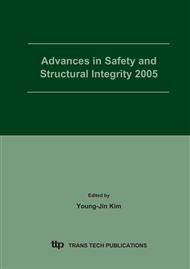p.15
p.23
p.31
p.39
p.45
p.55
p.63
p.71
p.79
Detection and Evaluation of Localized Damage under Creep-Fatigue Loading at 1000°F Using Acoustic Emission Technique
Abstract:
Acoustic emission (AE) technique was applied as a non-destructive test method to detect and evaluate the localized damage at high temperature environment. The creep-fatigue crack growth tests were carried out with the acquisition of AE signal at 1000°F. Under trapezoidal waveform loadings, AE results showed different features according to each damage mode. During the creep period, low and steady emissions were shown, while emissions were burst and high counts rate was recorded during the fatigue loading. Based on these characteristics, damage contribution was expressed in terms of acoustic emission parameter as a part-time monitoring method. Comparisons of damage contribution with respect to lifetime showed the transient behavior from cycle-dependent to time-dependent process. In case of full-time monitoring, bilinear behavior between AE counts and life was represented. From both monitoring results, it was confirmed that creep and fatigue damage can be characterized by means of emission features and AE is possible way to evaluate the localized damage at elevated temperature.
Info:
Periodical:
Pages:
45-54
Citation:
Online since:
March 2006
Authors:
Keywords:
Price:
Сopyright:
© 2006 Trans Tech Publications Ltd. All Rights Reserved
Share:
Citation:


